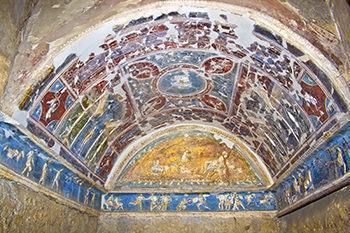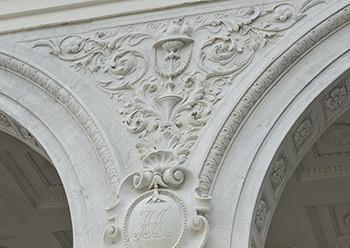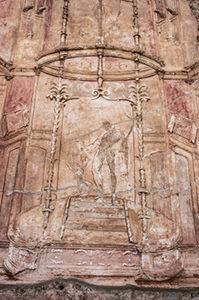Stucco or plastic decorations
Post from EditorialsThe stucco, ie the plastic decorations in relief including moldings, simulation of noble materials, friezes and figurative scenes, were very common in ancient times.
Stucco or plastic decorations
 The stucco is a particular type of surface finishing for buildings, consisting of any wall decoration in relief, made of a white plastic material (possibly colored or gold) that hardens in air, so without any reference to a specific material, because the stuccos can be realized with a mortar of lime, gypsum or bastard (ie with two ligands).
The stucco is a particular type of surface finishing for buildings, consisting of any wall decoration in relief, made of a white plastic material (possibly colored or gold) that hardens in air, so without any reference to a specific material, because the stuccos can be realized with a mortar of lime, gypsum or bastard (ie with two ligands).
From the point of view of history and technology, their use is very old and documented in almost all historical civilizations: we find columns covered with stucco already in the temples of ancient Greece, and even at some pre-Columbian civilizations, while the ancient Romans applied these decorations on wide scale, bordering on perfection (in the spa buildings, in large villas - including for example the Domus Aurea - and even in the Coliseum can still see the magnificent remains of polychrome stucco also, including frames, plant motifs and also figurative scenes).
We find a massive use of stucco also in architecture both during the High and the Low Middle Ages: particularly noteworthy are such friezes with plant motifs of Lombard Temple of Cividale del Friuli.
Finally, although the stucco have continued to be very popular in the Renaissance (also - but not exclusively - as a very economical surrogate of ornamental elements in stone or marble), the period of their maximum diffusion coincides however with Baroque and Rococo, because their ease of processing, low cost and versatility lends itself very well to realize the complex decorative apparatuses typical of these styles.
Figurative repertoire of the stucco
The scope - and therefore the figurative repertoire - of the stucco is so widespread, and includes both purely architectural decorations (such as the reasons rusticated and moldings) and friezes (geometric or figurative motifs such as plant matter, trophies of arms and cherubs/ cupids) and entire figurative scenes, particularly widespread eg in buildings from Roman times (in thermal environments, times were in fact almost always made of polychrome stucco), Baroque and Rococo.
Processing of the stucco
Materials
 The plasters are always made from a mortar white, whose binder can vary depending on both the historical periods (in Roman architecture during the Middle Ages and is preferred for example stucco lime, while in the Renaissance and the Baroque period seems to prevail the use of the gypsum), which by the characteristics and location of the decoration: for example, a mortar made up of gypsum, water and additives (glues, casein, arabic gum), while being very suitable for the production of plastic decorations, because thanks to the absence of the withdrawal is not necessary to add any aggregate (and therefore can realize particular also very minutes), if placed on the outside is not very durable, because the plaster is strongly hygroscopic. For outdoor stucco was preferred then a lime mortar or bastard (usually gypsum and lime).
The plasters are always made from a mortar white, whose binder can vary depending on both the historical periods (in Roman architecture during the Middle Ages and is preferred for example stucco lime, while in the Renaissance and the Baroque period seems to prevail the use of the gypsum), which by the characteristics and location of the decoration: for example, a mortar made up of gypsum, water and additives (glues, casein, arabic gum), while being very suitable for the production of plastic decorations, because thanks to the absence of the withdrawal is not necessary to add any aggregate (and therefore can realize particular also very minutes), if placed on the outside is not very durable, because the plaster is strongly hygroscopic. For outdoor stucco was preferred then a lime mortar or bastard (usually gypsum and lime).
The most widespread chalk was the cooked one or for plasterers, obtained by baking at a temperature of about 160° the chalky rocks (such as selenite). It is also documented the use of canary grass, consisting of a mixture of plaster for plasterers, finely chopped selenite and animal glue: the addition of such additives was recommended not only to make the filler more workable (increasing the plasticity and the speed gripping and slowing instead the hardening), but also to improve the mechanical strength.
Regarding the stucco lime, sources recommend instead a mortar formed from slaked lime of excellent quality and carefully sieved to eliminate any kind of impurities, water, fine sand and marble dust (better if Carrara).
For the preparation of mortar, finally, the rules of the art require to start the dough by combining lime and fine sand on a tablet or in a tub, giving the mortar thus obtained in the form of a basin in which to add the plaster in an amount sufficient to absorb all the water in excess: the end result must be in fact a smooth paste and compact for use at the time, because once hardened is useless.
Performance techniques
 In addition to the methods normally used for elements of plaster shaped (ashlar and moldings), for the stucco are two possible further execution systems, possibly combined in the same decoration. The most complex parts, in the round or with undercut regions, were formed out of work with the use of special molds made of wood or plaster, usually divided into several parts to be embedded between them with the notches and carefully lubricated with oil and Marseille soap to allow for the removal work is finished.
In addition to the methods normally used for elements of plaster shaped (ashlar and moldings), for the stucco are two possible further execution systems, possibly combined in the same decoration. The most complex parts, in the round or with undercut regions, were formed out of work with the use of special molds made of wood or plaster, usually divided into several parts to be embedded between them with the notches and carefully lubricated with oil and Marseille soap to allow for the removal work is finished.
Even in the processing work in the molds were used, which in this case consisted of large matrices similar to the stamps pressed on the stucco still fresh, allowing to model complex elements in a very short time and serial as Greek, festoons of leaves or small putti. The most common method for processing in place, however, is modeling by hand with spatula or slats, which are essential to achieve complex scenes and figurative motifs.
79164 REGISTERED USERS










